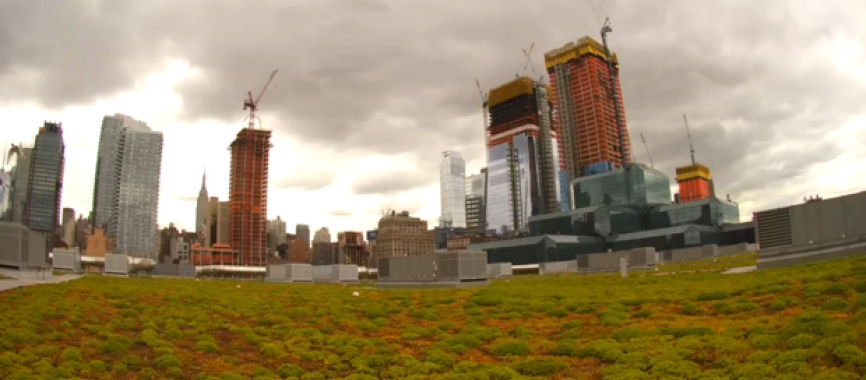Green Roofs Are Saving Birds and Hatching Bird-Watchers
Urban development hasn’t always accommodated birds. Window collisions due to reflective glass and bright lights have hurt migrating bird populations wherever there are skyscrapers, with the American Bird Conservancy estimating that each year, up to a billion birds die via collisions in the U.S. alone.
An overnight storm this past March left 395 warblers and orioles dead outside the 23-story One Moody Plaza in Galveston, Texas. The skyscraper is among the tallest in the area, and while it’s not wrapped in bird-unfriendly, floor-to-ceiling glass, a combination of lightning, building lights, and corner windows still disoriented the migrating birds into colliding with the structure.
However, when ecology and engineering unite, city roofs can become bird-roosting and bird-watching havens. Take New York City’s Jacob K. Javits Convention Center. New York City Audubon once ranked this I. M. Pei-designed fusion of glass and steel among the top three bird-killing buildings in the area. But since its 2009 renovation by FXFOWLE Architects, retrofitted low-reflectivity glass has reduced collisions by 90 percent. The new windows feature dot patterns visible to birds from the air, and a 6.75-acre green roof tops off the overhaul, ensuring that it not only kills fewer passing birds, but also feeds and shelters growing numbers.
“Having a building with a green roof on it, you're creating another layer where birds can interact with grass,” says Susan Elbin, director of conservation and science at NYC Audubon. The organization collaborated with Fordham University in 2014 to study wildlife at the Javits Center, counting 11 bird species utilizing the roof, including herring gulls that had started a colony, a first occurrence in New York. The following year, researchers found 17 bird species on the roof.
NYC Audubon’s next project will collate green roofs into an online database. The initiative won a $40,000 New York Community Trust grant this past April and counts the New York State Department of Environmental Conservation, the Port Authority of New York and New Jersey, and the Nature Conservancy among its research partners. Elbin says that one of the biggest challenges to designing green roofs is the lack of standardization among the landscape architects building them and the ecologists monitoring them. Elbin says green roofs of various sizes will be included in the database, whether private or public, formal or informal. The grant timeline is a year, so by April 2018, Elbin hopes to create cross-disciplinary dialogues about the locations, protocols, and environmental characteristics of existing and future New York green roofs.
“We need to have a common language in place,” Elbin says of the project. “We need to come up with working definitions and descriptions of green roofs. We need to be speaking with people who are creating the roofs and maintaining them.”
View from the top
Meanwhile, as the built environment becomes friendlier to avian neighbors, it’s changing bird-watching, too.
To bird-watch in cities, one need only look up—or, increasingly, climb to the roof. In 2009, inspired by the view from the ground, the ornithologist David Lindo—nicknamed the Urban Birder—decided to attempt a closer view of the flocks of wood pigeons in the West London skies. “They were so beautiful to watch from down below,” Lindo recalls. “In 90 minutes, I had seen roughly 16,000 or 17,000 of them fly over. I wanted to get elevated to try and see this from a higher perspective.”
Lindo started contacting high-rises around the city about roof access. His lucky break came when the property managers of Tower 42 agreed to let him up. Stoic and sterile in typical postwar fashion, the 47-story structure is neither a standout in height nor in eco-friendliness, but for bird-watching, its flat, fenced roof is ideal.
Lindo’s chance rooftop visit turned into the Tower 42 Bird Study Group, whose weekly sessions feature not only wood pigeons but also peregrines, kestrels, and anything that flies over London skies. The group began partnering with the London Wildlife Trust last month as part of the City of London’s wider efforts to survey bird populations in the region.
Over the past decade, Lindo has visited about 270 cities, wildlife-spotting from landmarks like Taipei 101 and a former League of Communists of Yugoslavia headquarters in Belgrade, Serbia.
“One of the things that I teach and preach is for people to get on roofs all over the world,” Lindo says. “It's my life's mission to engage with people who may not have thought of birds and wildlife before.”
Read full article @ CitiLab.





